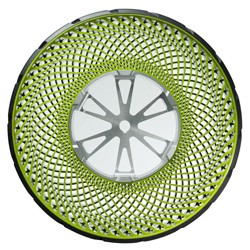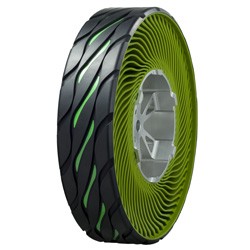Airless Tyres
The announcement that Bridgestone was developing an “airless” or non-pneumatic tyre for the passenger vehicle market sparked the interest of many drivers. Although this prototype is still being developed, the future looks bright for this revolutionary tyre.


Bridgestone airless tyre technology features a unique spoke structure designed to support the weight of a vehicle, effectively eliminating the need to periodically refill the tyres with air.
In 2013, Bridgestone revealed its second generation air free concept non-pneumatic tyre featuring improved load-bearing capabilities, environmental design and driving performance. However, there are developments and enhancements to be made before airless tyres are available for consumers. Finding a way to avoid trapping debris within the spokes, as well as developing the best way to distribute weight evenly and consistently transmit loads are a couple of these hurdles. For reasons like these, many spectators think airless tyres are still a decade or so away.
Despite this, the demand to keep up with the continuous advancements in the auto industry suggest that airless tyres would be a welcome step forward for consumers as well as the auto industry.
Currently, most airless tyres on the market are made from solid rubber or plastic. Golf carts, trailers and lawnmowers are a few examples of these tyres being used in commercial applications.
Benefits of Airless Tyres for Cars
No Flat Tyres – Ever
With airless tyres, you never have to worry about your tyres leaking because--you knew this was coming--non-pneumatic tyres have no air to leak. For most drivers, this feature will sound nothing short of revolutionary. When you run over a sharp object in the road, you won’t have to worry about a flat tyre because tyres without air can’t go flat. An end to the days of changing a tire on the highway shoulder would be welcome to drivers everywhere.
You Won’t Need A Spare Tyre
Since you won’t be changing or repairing a flat, you don’t need to carry a spare. Just like cars using run-flat tyres, this feature could free up trunk space. No spare also means less weight and less weight means better fuel economy
Vehicle-Heavy Industries Can Save Money
Airless tyres also may offer other specific advantages for trucks in industrial application. In the farming, mining, and construction industries, tyre failure can cause a loss of productivity and efficiency. Tyres that never leak or puncture would be a welcome advancement.
Reduced CO2 Emissions
About 90% of energy loss from tyre rolling resistance comes from repeated changes in the shape of the tries as they roll. By simplifying the structure of the tyre, Bridgestone was able to minimise the energy loss in these “air free concept tyres.” As a result, these tyres have the same level of low rolling resistance as Bridgestone pneumatic fuel efficient Ecopia tyres, contributing to reductions in CO2 emissions.
Eco-Conscious
The airless concept tyre is one of the initiatives aimed toward Bridgestone’s long-term vision of the use of sustainable materials. The materials used in the tyre are recyclable, contributing to the efficient use of resources. No part of a non-pneumatic tyre ever needs to go in the garbage, which goes hand-in-hand with Bridgestone’s effort to create a “cradle-to-cradle” system in which all tyres are first recycled and then factory-refashioned into new tyres. Airless tyres will be among the first for which this process is a reality.
The Future
Bridgestone is advancing development of the air-free concept tyre are a more environmentally friendly product than existing tyres and aims to bring about commercial use in a wide range of vehicles as soon as possible.
Bridgestone believes that through effective resource usage and efficient operations alongside CO2 emissions from improved fuel efficiency, as part of its aim to achieve a balance between its business and the environment, it can continue to offer attractive products to its consumers far into the future. Bridgestone will continue to implement multiple technological innovations to help bring about a more sustainable society.
-
Tyre Safety for All Drivers
Tyre Safety for All Drivers
As with just about everything on your car, paying attention and being proactive to your tyres are the keys to a successful trip. Here are a few tips for avoiding trouble on the road ahead.
Click to Learn More -
Tyre Tread Wear & Causes
Tyre Tread Wear & Causes
As tyres are used, the tread gradually becomes shallower, impacting overall tyre performance. But tyres don't all wear the same; here's what you should know about what causes tyre wear.
Click to Learn More -
It's Time for a Change: Run-Flat Technology
It's Time for a Change: Run-Flat Technology
At Bridgestone, we've always been in the fast lane when it comes to innovation. Today, we're still leading the pack, with the introduction of Run-Flat Technology, the first full line of run-flat tyres - tyres that keep you moving, even after a puncture.
Click to Learn More